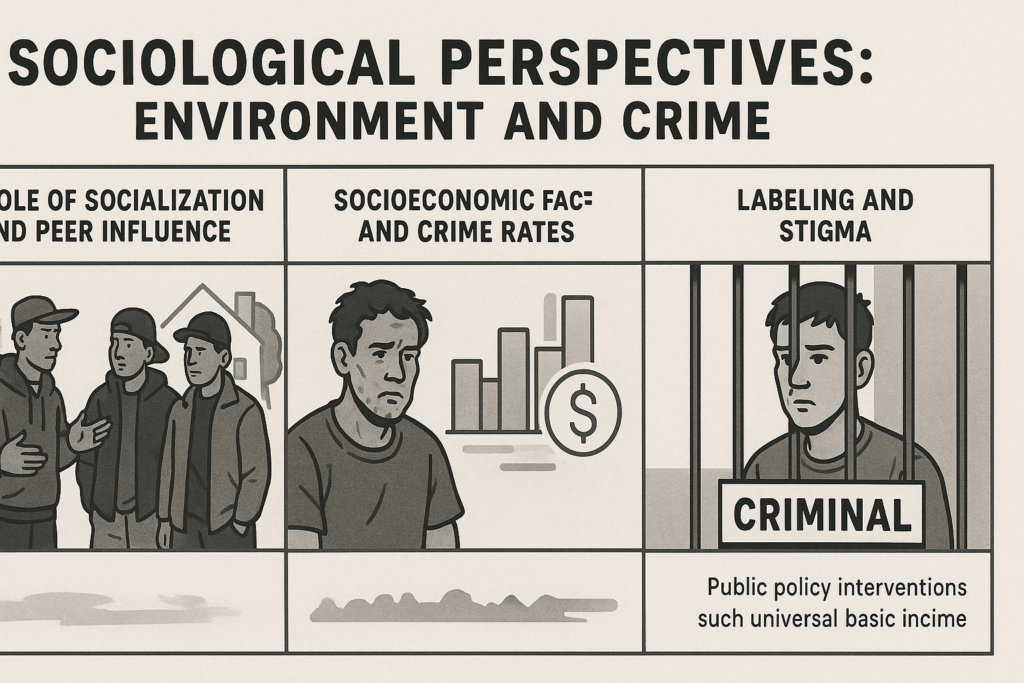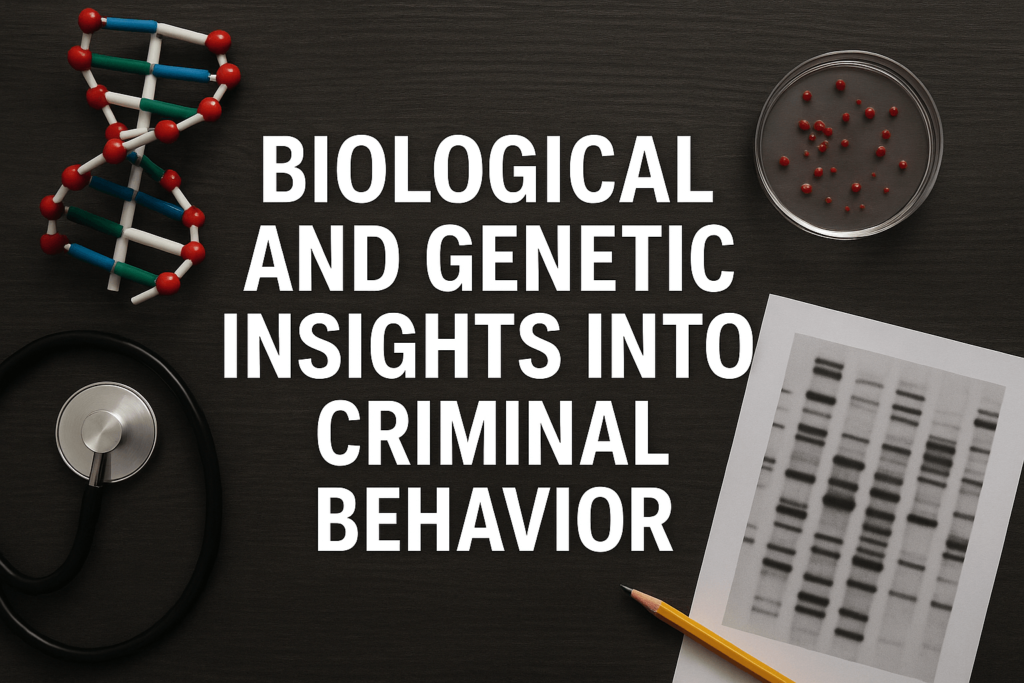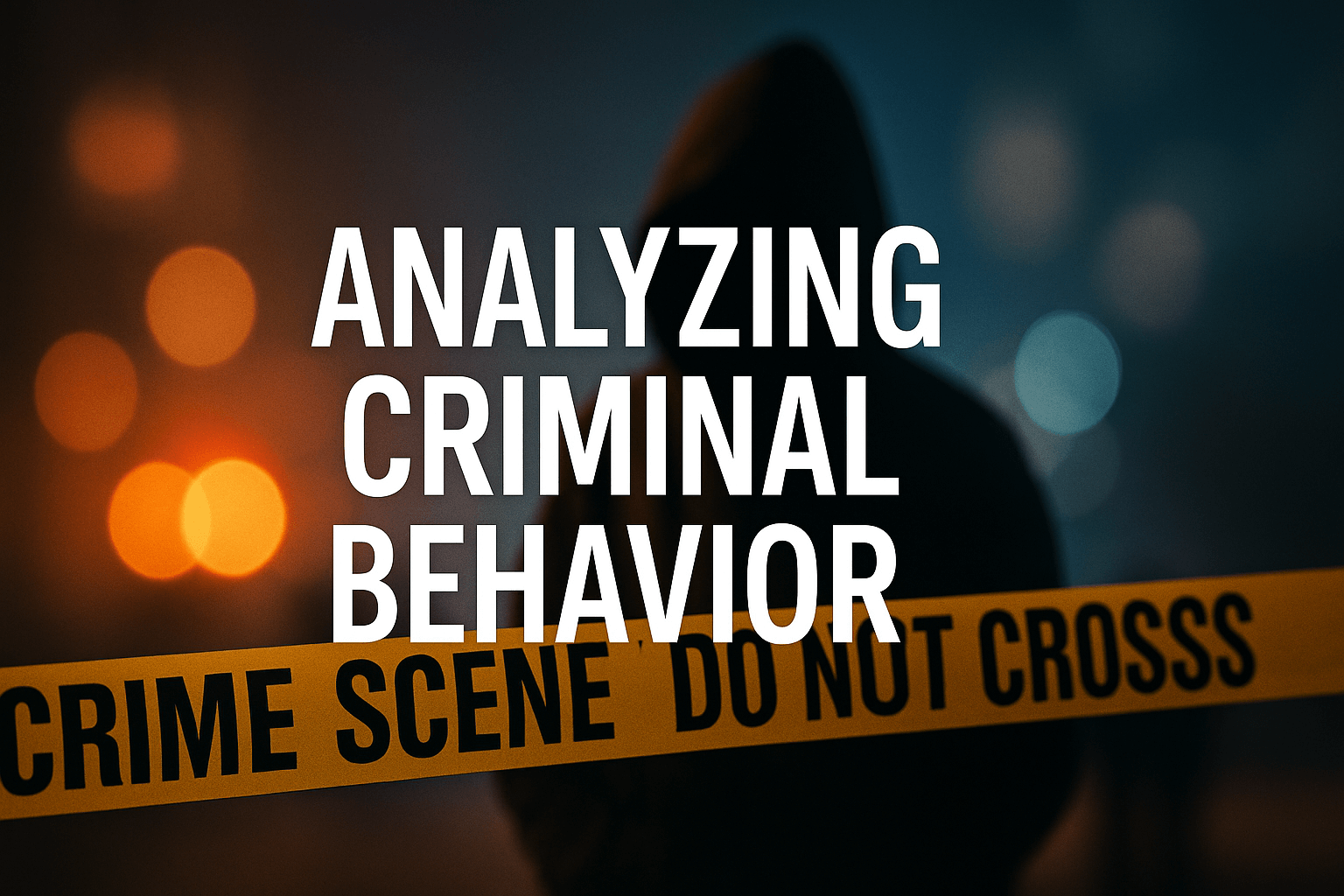Introduction: Why Analyzing Criminal Behavior Matters
Understanding the causes and manifestations of criminal behavior is a cornerstone of modern criminology. Through the lens of psychology, sociology, biology, and law, analyzing criminal behavior helps researchers, law enforcement, and policymakers develop effective strategies for crime prevention, rehabilitation, and justice. This article explores the most significant approaches used in the study of criminal behavior and highlights their implications for modern criminological practice.
In today’s increasingly complex societies, crime is shaped by a wide range of dynamic factors. Globalization, migration, technological advancement, and economic disparity all contribute to evolving patterns of criminal behavior. Analyzing these patterns requires not only academic rigor but also practical adaptability to shifting social realities.
Moreover, analyzing criminal behavior offers a critical lens through which to understand systemic issues such as inequality and institutional bias. By identifying root causes, criminologists can challenge punitive models and advocate for restorative justice systems.
Additionally, with the expansion of transnational crime networks and online offenses, there is a rising need to incorporate global perspectives into the analysis of criminal behavior. Understanding how cultural, political, and economic differences shape criminal motives and operations helps institutions develop more comprehensive international policies for crime prevention and justice reform.
The Foundations of Criminal Behavior Analysis
The Interdisciplinary Nature of Crime Study
Criminal behavior cannot be understood from a single perspective. Instead, it requires an interdisciplinary approach that combines:
- Psychological theories of personality, cognition, and trauma.
- Sociological frameworks such as social learning, strain theory, and labeling.
- Biological explanations including genetics and neurophysiology.
- Legal principles that define criminal acts and culpability.
Each of these domains contributes to a more holistic understanding of why individuals commit crimes and how society can respond effectively.
The integration of these disciplines allows for a more accurate classification of criminal behavior types—such as violent, white-collar, organized, or opportunistic crimes. This classification can then inform targeted intervention programs tailored to specific offender profiles.
Institutions such as universities and forensic research centers are increasingly promoting collaborative studies involving sociologists, neuroscientists, psychologists, and legal scholars. This cross-disciplinary research is paving the way for innovative methodologies and hybrid theories that better reflect the complexities of criminal behavior.
Furthermore, interdisciplinary approaches foster a systems-level understanding of crime. For instance, public health models now collaborate with criminology to view violence as a contagion that can be interrupted. This conceptual shift redefines prevention as a collective societal responsibility rather than solely a criminal justice issue.
Psychological Approaches to Analyzing Criminal Behavior
Personality Traits and Criminal Tendencies
Psychologists have long investigated whether certain personality traits are more common among offenders. Research suggests that traits like impulsivity, aggression, and low empathy are frequently observed among those who engage in antisocial or violent behaviors.
Studies using the Five-Factor Model (Big Five personality traits) have identified low agreeableness and low conscientiousness as traits significantly correlated with criminal behavior. These insights are used in both psychological risk assessments and rehabilitation planning.
Additionally, psychopathy—measured through tools like the Hare Psychopathy Checklist—is a strong predictor of repeat violent offenses. Understanding the psychological composition of such individuals enables courts and correctional institutions to make informed decisions regarding sentencing and parole.
Moreover, personality traits often interact with environmental stimuli, shaping how individuals respond to stress or social rejection. For instance, individuals with high impulsivity may be more likely to engage in spontaneous criminal acts when exposed to adverse situations, suggesting that both internal disposition and external context are important in predicting behavior.
Cognitive Theories and Moral Development
Cognitive theories emphasize how criminals think, reason, and justify their actions. Notably, Kohlberg’s stages of moral development show that some individuals commit crimes due to underdeveloped moral reasoning.
Research has also explored the concept of “neutralization techniques,” where offenders justify their behavior through denial of harm, denial of responsibility, or dehumanization of victims. These cognitive distortions serve as psychological defense mechanisms to reduce guilt.
Intervention programs focusing on cognitive-behavioral therapy (CBT) aim to reshape distorted thinking patterns. Such therapies have shown promising results in reducing recidivism rates, especially among juvenile offenders.
Recent advances in neurocognitive studies have demonstrated that certain cognitive deficits, such as poor impulse control and lack of empathy, are strongly associated with criminal activity. By addressing these deficits through therapy and skill-building, it may be possible to reduce future criminal behavior and improve reintegration outcomes.
Mental Illness and Crime
While mental illness does not cause crime, certain untreated conditions—such as psychosis or severe personality disorders—can increase the risk of criminal acts. The analysis of these cases requires both psychiatric evaluation and legal judgment.
The insanity defense, although rare, reflects society’s recognition that certain mental conditions may impair judgment to the extent that legal responsibility is diminished. However, misuse or misunderstanding of this defense continues to be a topic of public concern and academic debate.
Recent research also explores the intersection of trauma, PTSD, and criminal behavior, particularly among veterans and abuse survivors. Addressing mental health not only aids individuals but also contributes to safer communities.
Additionally, access to mental health services remains a barrier for many offenders both within and outside the prison system. Enhancing psychological support in correctional facilities and integrating mental health into probation programs can reduce repeat offenses and support long-term rehabilitation.
Sociological Perspectives: Environment and Crime
The Role of Socialization and Peer Influence
Sociological theories assert that criminal behavior is learned through interaction with others. Edwin Sutherland’s Differential Association Theory argues that individuals learn criminal values and skills from their social environment.
Empirical studies on gang culture illustrate how peer groups provide identity, support, and protection—often in environments lacking positive role models. This social bond can lead to a normalization of violence and deviance.
Schools, neighborhoods, and media also play a role in shaping attitudes toward crime. Prevention strategies now focus on community engagement and mentorship programs to counteract negative peer influence.
In addition to peer influence, the absence of positive role models and family support systems significantly increases vulnerability to criminal behavior. Children growing up in environments marked by neglect, domestic violence, or substance abuse are more likely to adopt deviant behaviors as normalized responses to their conditions. Early intervention in such cases—through education, mentorship, and counseling—can drastically shift life trajectories.
Socioeconomic Factors and Crime Rates
Poverty, unemployment, and lack of education can create conditions where criminal activity becomes a means of survival or empowerment. Strain Theory, developed by Robert Merton, explains how individuals under pressure to achieve societal goals may resort to illegitimate means.
Structural inequality exacerbates the cycle of crime. Marginalized communities often experience over-policing yet under-protection, further fueling distrust in authorities and reliance on informal systems of justice.
Public policy interventions such as universal basic income, job training, and affordable education have shown potential in mitigating crime rates by addressing these structural deficiencies.
The link between economic instability and crime is further intensified during times of crisis, such as recessions or pandemics. During such periods, theft, fraud, and domestic violence often surge. This reveals the critical role of social safety nets and community resilience in mitigating criminal activity. Governments must consider long-term economic equity as a tool for crime prevention.
Labeling and Stigma
The Labeling Theory posits that individuals become criminals when society labels them as such, often leading to a self-fulfilling prophecy. This has profound implications for how we treat young offenders and ex-convicts.
Juvenile detention centers often act as breeding grounds for future crime when young individuals internalize their criminal identity. Diversion programs focused on restorative justice aim to interrupt this cycle early.
The stigma attached to criminal records can hinder reintegration into society. Policies such as “ban the box” initiatives aim to reduce discrimination against ex-offenders in employment.
Beyond employment challenges, social stigma can also lead to psychological distress and further marginalization. Individuals labeled as “criminals” may internalize societal rejection, leading to low self-esteem, hopelessness, and continued deviance. This highlights the importance of inclusive language, rehabilitation programs, and community support in reducing recidivism and promoting reintegration.

Biological and Genetic Insights into Criminal Behavior
Are Criminals Born or Made?
This age-old question is central to biological criminology. Studies in behavioral genetics suggest that certain inherited traits may predispose individuals to criminal behavior—but always in interaction with environmental factors.
Twin and adoption studies have shown that identical twins are more likely to exhibit similar criminal tendencies than fraternal twins, supporting a genetic component. However, shared environment still plays a major role.
Epigenetics is emerging as a frontier in criminology, studying how environmental stressors can activate or deactivate genetic expression related to aggression or impulse control.
It’s also crucial to note that genetic predisposition does not determine destiny. The presence of certain genes may increase vulnerability, but their expression is influenced by life experiences, upbringing, and social context. This reinforces the idea that while biology matters, environmental intervention can redirect behavioral outcomes.
Brain Structure and Neurochemistry
Advances in neuroscience have revealed that abnormalities in brain areas such as the prefrontal cortex and amygdala may influence aggression, impulse control, and decision-making—factors commonly linked to violent behavior.
Imaging studies have found that offenders often show reduced activity in the orbitofrontal cortex, a region associated with ethical decision-making and empathy. These findings raise questions about moral culpability.
Neurotransmitter imbalances, particularly low serotonin levels, have been linked to impulsive aggression. Treatments aimed at regulating brain chemistry could one day complement traditional rehabilitation methods.
Further research has linked frontal lobe damage and reduced activity in the anterior cingulate cortex with poor emotional regulation and impulsivity. These neurobiological markers are now being studied in juvenile populations to inform early prevention strategies. However, ethical concerns remain about labeling children based on neurological risk factors.

Modern Tools and Technologies in Crime Analysis
Criminal Profiling
Using psychological and behavioral patterns, criminal profiling helps law enforcement predict and identify unknown offenders. Profilers analyze crime scenes, victimology, and offender behavior to build detailed suspect profiles.
Although popularized in media, criminal profiling remains a controversial tool. Critics argue it relies too much on subjective interpretation, while proponents cite cases where it has accurately narrowed down suspect pools.
Profiling is now being supplemented with machine learning algorithms to analyze larger datasets and identify patterns too complex for human analysis alone.
Profiling is increasingly incorporating cultural and situational variables. For instance, profiling methods in urban environments differ significantly from those used in rural or conflict zones. The adaptability of profiling techniques to context ensures more accurate predictions and reduces the risk of wrongful accusations.
Data Analysis and Predictive Policing
Big data and AI are revolutionizing how crime is analyzed. By identifying patterns in large datasets, predictive policing technologies can forecast where crimes are likely to occur, enabling proactive responses.
However, predictive policing faces criticism for reinforcing racial biases embedded in historical data. Transparency and community oversight are essential to prevent discriminatory outcomes.
GIS mapping, social network analysis, and real-time surveillance are being integrated into law enforcement strategies. These tools must be balanced with strong legal frameworks to ensure ethical use.
Some cities have begun integrating community feedback mechanisms into predictive policing algorithms. This participatory model helps identify errors or biases in the data and fosters trust between law enforcement and the public. It represents a progressive step toward more ethical and responsive use of technology.
Forensic Psychology
This growing field merges psychology with the criminal justice system. Forensic psychologists assess competency, criminal responsibility, and risk of recidivism, contributing valuable insights in courtrooms and correctional settings.
Forensic evaluations are also used in determining child custody, witness credibility, and parole suitability. Their recommendations often carry significant weight in legal decisions.
The field continues to evolve with new methods for lie detection, trauma assessment, and behavior prediction, all contributing to a more evidence-based justice system.
The field is also evolving to address cultural and gender sensitivity. Forensic assessments now increasingly consider cultural norms, trauma histories, and identity-related stressors when evaluating suspects or victims. This more holistic approach ensures greater fairness and psychological accuracy in legal contexts.
Ethical Considerations in Analyzing Criminal Behavior
While technology and science enhance our ability to understand criminal behavior, they also raise ethical concerns. These include:
- Privacy and surveillance.
- Racial and socioeconomic biases in profiling.
- Overreliance on algorithms in criminal justice decisions.
Ethical analysis ensures that criminological methods respect individual rights and promote fairness.
One of the most debated issues is the use of facial recognition software and biometric data, which can lead to wrongful accusations and invasion of privacy if not properly regulated.
Ethics also apply to academic research involving offenders. Informed consent, confidentiality, and non-maleficence are critical principles in criminological research.
Ethical frameworks must also account for consent and transparency when collecting behavioral data. For example, the use of wearable tracking devices or monitoring software in correctional settings must be regulated to protect human dignity. Clear guidelines and independent oversight are essential to prevent misuse of such tools.
The Role of Criminal Behavior Analysis in Crime Prevention
Analyzing criminal behavior doesn’t just help us understand crime—it plays a key role in preventing it. Applications include:
- Early intervention programs for at-risk youth.
- Rehabilitation strategies for offenders.
- Policy development that addresses root causes, not just symptoms.
When rooted in sound analysis, prevention becomes more effective and humane.
Community-based programs that engage former offenders as mentors have shown particular success in reducing youth violence and gang involvement.
Behavioral threat assessment is increasingly used in schools and workplaces to identify potential perpetrators before violence occurs—showing the preventative power of behavioral analysis.
Data-driven prevention models are now being used in schools, workplaces, and public spaces to detect early warning signs. For example, anonymous reporting systems and behavioral risk assessments can identify individuals in distress before a crisis occurs. Prevention thus becomes proactive rather than reactive.
Conclusion: The Future of Criminal Behavior Analysis
As society evolves, so too must our understanding of crime. Whether through advanced technologies, deeper psychological insights, or new social paradigms, the study of criminal behavior remains an essential tool for justice, safety, and reform. For professionals, researchers, and students alike, analyzing criminal behavior offers a dynamic and impactful path toward reducing harm and building a more just society.
Future directions in this field may include integrating virtual reality for offender rehabilitation, using biofeedback in behavioral monitoring, and expanding the use of AI for mental health screening in correctional settings.
Ultimately, analyzing criminal behavior is not just about understanding “the criminal”—it’s about understanding society, its failures, and its opportunities for redemption.
Looking ahead, integrating criminological analysis with social innovation will be key. Collaborative networks between law enforcement, tech companies, educators, and healthcare providers can offer new solutions to old problems. A future grounded in empathy, evidence, and equity has the power to redefine justice for generations to come.
References:
- National Institute of Justice (NIJ). Crime and Criminal Justice Research. Retrieved from:
https://nij.ojp.gov/topics/crime-and-criminal-justice-research - American Psychological Association (APA). Criminology and Psychology Topics. Retrieved from:
https://www.apa.org/topics/criminology - Bureau of Justice Statistics (BJS). U.S. Department of Justice Crime Data and Analysis. Retrieved from:
https://www.bjs.gov/ - Beaver, K. M., Wright, J. P., & Boutwell, B. B. (2016). Genetics and Crime: Integrating New Findings into Public Policy. National Center for Biotechnology Information (NCBI). Retrieved from:
https://www.ncbi.nlm.nih.gov/pmc/articles/PMC4998927/ - United Nations Office on Drugs and Crime (UNODC). Global Crime and Analysis Reports. Retrieved from:
https://www.unodc.org/unodc/en/data-and-analysis/crime.html - The Sentencing Project. Research and Advocacy for Criminal Justice Reform. Retrieved from:
https://www.sentencingproject.org/research/ - Australian Psychological Society (APS). What is Forensic Psychology? Retrieved from:
https://www.psychology.org.au/forensic-psychology

